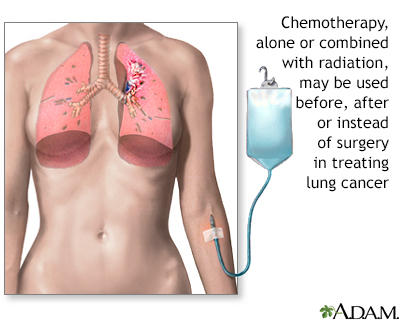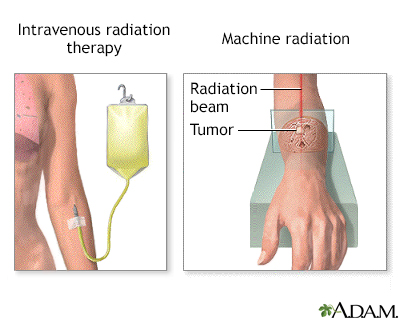Cancer treatments
If you have cancer, your health care provider will recommend one or more ways to treat the disease. The most common treatments are surgery, chemotherapy, and radiation. Other options include targeted therapy, immunotherapy, laser, hormonal therapy, and others. Here is an overview of the different treatments for cancer and how they work.
Surgery
Surgery is a common treatment for many types of cancer. During the operation, the surgeon takes out the mass of cancerous cells (tumor) and some of the nearby tissue. Sometimes, surgery is done to relieve side effects caused by a tumor.
Chemotherapy
Chemotherapy refers to medicines used to kill cancer cells. The medicines may be given by mouth or into a blood vessel (IV). Different types of medicines may be given together at the same time or one after the other.
Radiation
Radiation therapy uses x-rays, particles, or radioactive seeds to kill cancer cells. Cancer cells grow and divide faster than normal cells in the body. Because radiation is most harmful to quickly growing cells, radiation therapy damages cancer cells more than normal cells. This prevents the cancer cells from growing and dividing, and leads to cell death.
The two main types of radiation therapy are:
- External beam. This is the most common form. It aims x-rays or particles at the tumor from outside the body.
- Internal beam. This form delivers radiation inside your body. It may be given by radioactive seeds placed into or near the tumor; a liquid or pill that you swallow; or through a vein (intravenous, or IV).
Targeted Therapies
Targeted therapy uses medicines to stop cancer from growing and spreading. It does this with less harm to normal cells than other treatments.
Standard chemotherapy works by killing cancer cells and some normal cells. Targeted treatment zeroes in on specific targets (molecules) in cancer cells. These targets play a role in how cancer cells grow and survive. Using these targets, the medicine disables the cancer cells so they cannot spread.
Targeted therapy medicines work in a few different ways. They may:
- Turn off the process in cancer cells that causes them to grow and spread
- Trigger cancer cells to die on their own
- Kill cancer cells directly
Targeted therapies are given as a pill or IV.
Immunotherapy
Immunotherapy is a type of cancer treatment that relies on the body's ability to fight infection (immune system). It uses substances made by the body or in a lab to help the immune system work harder or in a more targeted way to fight cancer. This helps your body get rid of cancer cells.
Immunotherapy works by:
- Stopping or slowing the growth of cancer cells
- Preventing cancer from spreading to other parts of the body
- Boosting the immune system's ability to get rid of cancer cells
These medicines are designed to seek and attack certain parts of a cancer cell. Some have toxins or radioactive substances attached to them. Immunotherapy is given by IV.
Hormonal Therapy
Hormone therapy is used to treat cancers that are fueled by hormones, such as breast, prostate, and ovarian cancers. It uses surgery, or medicines to stop or block the body's natural hormones. This helps slow the growth of cancer cells. The surgery involves removing organs that make hormones: the ovaries or testes. The medicines are given by injection or as pills.
Hyperthermia
Hyperthermia uses heat to damage and kill cancer cells without harming normal cells.
It may be used for:
- A small area of cells, such as a tumor
- Parts of the body, such as an organ or limb
- The whole body
The heat is delivered from a machine outside the body or through a needle or probe placed in the tumor.
Laser Therapy
Laser therapy uses a very narrow, focused beam of light to destroy cancer cells. Laser therapy can be used to:
- Destroy tumors and precancerous growths
- Shrink tumors that are blocking the stomach, colon, or esophagus
- Help treat cancer symptoms, such as bleeding
- Seal nerve endings after surgery to reduce pain
- Seal lymph vessels after surgery to reduce swelling and keep tumor cells from spreading
Laser therapy is often given through a thin, lighted tube that is put inside the body. Thin fibers at the end of the tube direct the light at the cancer cells. Lasers are also used on the skin.
Lasers are most often used with other types of cancer treatment such as radiation and chemotherapy.
Photodynamic Therapy
In photodynamic therapy, a person gets a shot of a medicine that is sensitive to a special type of light. The medicine stays in cancer cells longer than it stays in healthy cells. Then, the doctor directs light from a laser or other source at the cancer cells. The light changes the medicine to a substance that kills the cancer cells.
Cryotherapy
Also called cryosurgery, this therapy uses very cold gas to freeze and kill cancer cells. It is sometimes used to treat cells that might turn into cancer (called pre-cancerous cells) on the skin or cervix, for example. Providers can also use a special instrument to deliver cryotherapy to tumors inside the body, such as the liver or prostate.
Images


References
American Cancer Society website. Treatment types. www.cancer.org/treatment/treatments-and-side-effects/treatment-types.html. Accessed March 19, 2024.
Doroshow JH. Approach to the patient with cancer. In: Goldman L, Cooney KA, eds. Goldman-Cecil Medicine. 27th ed. Philadelphia, PA: Elsevier; 2024:chap 164.
National Cancer Institute website. Types of cancer treatment. www.cancer.gov/about-cancer/treatment/types. Accessed March 19, 2024.
BACK TO TOPReview Date: 12/31/2023
Reviewed By: Todd Gersten, MD, Hematology/Oncology, Florida Cancer Specialists & Research Institute, Wellington, FL. Review provided by VeriMed Healthcare Network. Also reviewed by David C. Dugdale, MD, Medical Director, Brenda Conaway, Editorial Director, and the A.D.A.M. Editorial team.

Health Content Provider
06/01/2025
|
A.D.A.M., Inc. is accredited by URAC, for Health Content Provider (www.urac.org). URAC's accreditation program is an independent audit to verify that A.D.A.M. follows rigorous standards of quality and accountability. A.D.A.M. is among the first to achieve this important distinction for online health information and services. Learn more about A.D.A.M.'s editorial policy, editorial process and privacy policy. A.D.A.M. is also a founding member of Hi-Ethics. This site complied with the HONcode standard for trustworthy health information from 1995 to 2022, after which HON (Health On the Net, a not-for-profit organization that promoted transparent and reliable health information online) was discontinued. |
The information provided herein should not be used during any medical emergency or for the diagnosis or treatment of any medical condition. A licensed medical professional should be consulted for diagnosis and treatment of any and all medical conditions. Links to other sites are provided for information only -- they do not constitute endorsements of those other sites. © 1997- 2025 A.D.A.M., a business unit of Ebix, Inc. Any duplication or distribution of the information contained herein is strictly prohibited.
